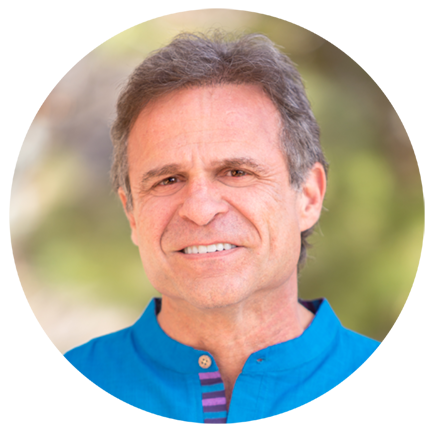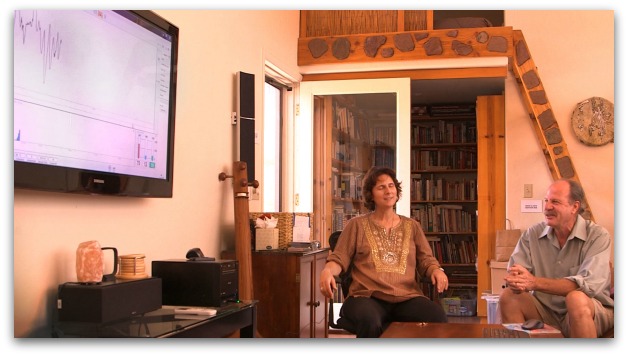HeartMath at The Sanctuary
A Coherent Life – At The Heart of Sustainable Addiction Recovery. HeartMath is a therapeutic modality founded in well-documented research from the field of neurocardiology. Informed by the heart’s critical role in our overall health, HeartMath sessions are conducted with simple, user-friendly technology through which our clients can access, monitor, and take control of their internal states. They learn to recognize chaotic internal states and to shift quickly into greater internal coherence, or more optimal overall functioning, with full access to higher brain functions, and an increased sense of well-being (2).
The science and technology of HeartMath is an integral part of our program at The Sanctuary. We collect baseline information as clients begin our program and follow their progress throughout their stays. Using computer software, we see data that reflects increasing internal coherence as a client progresses through the program. Not only is this evidence of HeartMath’s efficacy, but it reflects the efficacy of our program overall. The results are consistent and dramatic. We see that a person’s internal state becomes more consistently coherent as they progress through the work they do with us.
HeartMath Sessions
HeartMath technology allows us access to the continuous and closed conversational loop between the heart and brain as it occurs, in real-time. The logistics of a session are simple, gentle, and enjoyable. They involve a computer screen, software, coaching, and practice.
A non-invasive sensor is worn on the ear or finger, making heart rhythms visible and measurable on a computer screen as they occur. With that feedback, one learns to apply simple techniques to shift heart rhythms from more chaotic states to more orderly and coherent ones. The software used trains what is known as heart rate coherence. Basically, this means that a user learns to anticipate, control, and reverse the stress response. Our clients learn HeartMath techniques with us and are given the technology to take home with them so they may continue the practice.
The Goal of HeartMath
The overall goal of HeartMath is to achieve a state of optimal functioning and to return to one quickly as stress and distress arise in daily life. The implications for managing a substance-free life, or one free of traumatic reactions, anxiety, and depression, are dramatic. In short, HeartMath allows us to increase our health and overall resilience. We do so by consciously reducing the time we spend in a state of internal chaos. This enables us to establish and maintain a life that is characterized by all the things we hope life in recovery will be: organized, easily understood, integrated, cohesive, consistent, meaningful, and satisfying. It enables us to be resilient.
Resilience
Resilience is the “capacity to bounce back from adversity” (3). It reflects an intact core, a home base of life-affirming homeostasis. When life’s stress derails us, resilience allows us to return to core stability again. We return to a state of coherence where there is order, meaning, and health. Addiction, depression, anxiety, and trauma are catastrophic derailments. Until the core is stable again, we cannot bounce back from even small scale toppling.
HeartMath practice helps us find the coherent and life-affirming core as we need to. It is a reliable daily navigational tool. The more often we return to the core of coherence, the more coherence occurs across all systems inside us and out. Internally, for example, our immune system and nervous system are fortified, our high-performance cognitive abilities are engaged, and our ability to generate hormones and new cells is optimized in a state of coherence. Externally, greater coherence improves our ability to have meaningful and harmonious relationships with less aggressive impulses, more willingness to cooperate, and deeper, more meaningful connections (4,5).
Relapse Prevention
Our goal at The Sanctuary is to train our clients in HeartMath so they may achieve more harmonious emotional states, more synchronized physiology, more optimized activity in higher brain functions, and a greater connection to others in their communities. We have long known that these are valuable recovery milestones and that they lead to a dramatically different quality of abstinence—one that is far more manageable, comfortable, and steeped in resilience.
If people continue to practice what they learn with us in HeartMath sessions, they can significantly reduce their vulnerability to relapse. They can consciously reinforce resiliency daily, many times a day if necessary. This gets directly to the root of relapse dynamics that have haunted us relentlessly. The technology and techniques of HeartMath are revolutionary in relapse prevention; a full and sustainable recovery is possible.
Especially for those who have experienced multiple relapses, this technology offers profound hope. Lingering and residual distress can be addressed as it occurs so that relapse becomes far less of a possibility. For those just starting their recovery efforts, HeartMath is a powerful resource that can help them avoid the revolving rehab door altogether if they continue the practice in everyday life.
The Incoherent Life—Chaos, Distress, and Addiction
Far too many people have experienced the pain of an incoherent life. Particularly those who are addicted, and their loved ones, know all too well the profound pain of a chaotic life. When life does not make sense and has no orderly or predictable structure, purpose, or direction, our thoughts are disordered, tortured, and non-life affirming. Emotions are either numbed, depleting or tumultuous, and behavior is impulsive, compulsive, erratic, and destructive.
In such distress, whatever we try to build up, no matter how hard we try, will fall into disarray. We abandon our goals and projects, and we repeatedly summon up resolve, only to be pulled back into chaos. It is an insidious and pervasive state that anyone with an addiction can attest to. Eventually, the dynamics of such internal chaos will ripple across all realms of one’s life, taking its pain and destruction with it. Our lives always reflect what is happening inside us.
Order and chaos work out in life and occur on many levels—in how well our bodily organs work if our immunity is high or low if our emotions are stable or not, and whether our mental processes support a sense of meaning and purpose or leave us lost, afraid, anxious and depressed. Beyond that, we see evidence of our inner worlds in external life. Our internal states are reflected in such things, for example, as the status of our relationships and the overall trajectory of our lives.
Searching for the Coherent Life in Addiction Recovery
Unfortunately, countless people have summoned up great effort to recover, but have not been successful. Some have tried again and again only to return to substance use and a greater state of distress than ever before when their efforts yielded few results. The degree of chaos in one’s life increases exponentially as the addiction progresses and relapses recur. It begins to feel impossible to find the good, orderly direction that will lead you out of that distress.
Our field has struggled for years to help people, and it has taken a long time to thoroughly understand the workings of addiction, as well as what is necessary to recover from it. Science, however, is fueling our efforts every day. The Sanctuary has a significant advantage because we are a holistic program, open to innovation, constantly monitoring research, and willing to embrace everything of value that will benefit our clients. A good example of our approach is the integration of new science into our program that is based on some of the most dramatic scientific discoveries of recent years in the field of neuro-cardiology.
That research has proven that we have misunderstood a great deal about the true nature of being human and what it takes to maintain optimal health. It redirects our focus to the human heart and its critical role in determining whether ours is a life of distress and chaos or one of order and meaning.
Understanding the Human Heart
The human heart has been called the seat of the soul and the essence of humanity for thousands of years in spirituality, philosophy, poetry, and common parlance. There are many examples in our culture, and from around the world, in which metaphorical language describes the human heart as a profound, noble, and powerful source of life energy. For example, we identify the heart as the realm of our emotions. We cite loving, compassionate acts as expressions of the heart; wisdom, and courage as coming from the heart, and genuine communication as heartfelt. When we are hurt, sad, or grief-stricken, we say that our hearts are broken.
The Heart-Brain Connection
We now know that the heart makes its own decisions and informs the brain of them. With a neural network of its own that is much like that of the brain, the heart has the most complex and extensive neural connection to the brain of any system in the body (1). It is very much a sensory and thinking organ, using perception, and both short and long-term memory, as it makes decisions that affect us across all realms of functioning.
Rather than a subordinate to the brain as we’ve long conceptualized, the heart may be better understood as a partner to the brain. In many ways, it is the gatekeeper and choreographer of brain function. This information has dramatic implications for addiction treatment and recovery. It gives us significant access to the underlying disturbances that create chronic distress in addiction and other diseases such as trauma, anxiety, and depression.
Works Cited
-
Edwards, S. (2010). Evaluation of heart rhythm coherence feedback training on physiological and psychological variables. South African Journal of Psychology, 20 (10), 1–10.
-
Childre, D. L., Martin, H., & Beech, D. (1999). The HeartMath Solution: The Institute of HeartMath’s Revolutionary Program for Engaging the Power of the Heart’s Intelligence. New York City, NY: HarperCollins.
-
Van der Kolk, B. (2015). The Body Keeps the Score: Brain, Mind, and Body in the Healing of Trauma. New York, NY, Penguin.
-
Braden, G. (2015). Resilience from the Heart: The Power to Thrive in Life’s Extremes. Hay House.
-
Braden, G. (2010). Gregg Braden–Institute of HeartMath. Retrieved March 30, 2016, from https://www.youtube.com/watch?v=l8dKcvROnl4
If you would like more information, onA Coherent Life – At The Heart of Sustainable Addiction Recovery or any of our holistic non 12 step addiction recovery programs you can contact us
by phone at (877) 710-3385, or by email at [email protected]
Read more about Our Holistic Addiction Recovery Program

He is the Founder, Administrator, Counselor at the Sanctuary at Sedona.
He has a BA in Political Science and is currently Senior teaching staff at Four Winds Society, an international school of energy medicine. His credentials also include being an Ordained Minister; a Certified Shamanic Breathwork® Facilitator; a Founding Member Society for Shamanic Practitioners; a Member of Association for Comprehensive Energy Psychology; a Member of the National Institute for Holistic Addiction Studies. [email protected]


